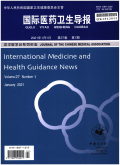rTMS联合头眼感觉运动整合训练在脑卒中偏瘫患者康复治疗中的应用
Application of repetitive transcranial magnetic stimulation combined with head-eye sensory-motor integration training in the rehabilitation treatment of post-stroke hemiplegia
摘要目的:探讨重复经颅磁刺激(rTMS)联合头眼感觉运动整合训练在脑卒中偏瘫康复治疗中的应用。方法:采用前瞻性研究方法,纳入2020年2月至2023年2月德州市立医院收治的102例脑卒中偏瘫患者作为研究对象,采用摸球法分组,奇数为对照组(51例)、偶数为观察组(51例)。对照组男26例、女25例,年龄(65.23±7.14)岁,进行常规康复治疗;观察组男25例、女26例,年龄(64.89±7.31)岁,在对照组基础上给予rTMS联合头眼感觉运动整合训练,连续治疗6周。治疗前后采用蒙特利尔认知评估量表(MoCA)、简化Fugl-Meyer运动功能评定量表(FMA)、改良Barthel指数(MBI)及简易精神状态评价量表(MMSE)对两组患者进行评估,比较两组患者临床疗效、康复效果满意度。采用 t检验、 χ2检验进行统计分析。 结果:观察组临床治疗总有效率为92.15%(47/51),高于对照组的76.47%(39/51),差异有统计学意义( χ2=4.744, P=0.029)。治疗2个月后,观察组MoCA评分、FMA评分、MBI评分、MMSE评分均高于对照组[(26.84±5.32)分比(21.34±4.51)分、(62.38±14.86)分比(53.81±13.27)分、(69.24±21.07)分比(56.75±16.53)分、(28.47±2.01)分比(25.06±1.94)分],差异均有统计学意义( t=5.631、3.072、3.331、8.717,均 P<0.05)。观察组康复效果总满意度为90.19%(46/51),高于对照组的72.55%(37/51),差异有统计学意义( χ2=5.239, P=0.022)。 结论:rTMS联合头眼感觉运动整合训练在脑卒中偏瘫康复治疗中具有显著的临床疗效和康复效果,改善认知功能、运动功能和日常生活能力,具有推广价值。
更多相关知识
abstractsObjective:To explore the application of repetitive transcranial magnetic stimulation (rTMS) combined with head-eye sensory-motor integration training in the rehabilitation treatment of post-stroke hemiplegia.Methods:A prospective research method was used. From February 2020 to February 2023, 102 post-stroke hemiplegic patients admitted to Dezhou Municipal Hospital were enrolled in the study, and were divided into a control group with odd numbers and an observation group with even numbers by the ball-drawing method. In the control group, 26 males and 25 females, aged (65.23±7.14) years, received routine rehabilitation treatment. In the observation group, 25 males and 26 females, aged (64.89±7.31) years, were given rTMS combined with head-eye sensory-motor integration training on the basis of control group, with a course of treatment of 6 weeks. The two groups were evaluated before and after treatment using the Montreal Cognitive Assessment (MoCA), simplified Fugl-Meyer Motor Function Rating Scale (FMA), modified Barthel Index (MBI), and Mini-Mental State Examination (MMSE). The clinical efficacy and satisfaction with the rehabilitation effect were compared between the two groups. t test and χ2 test were used for statistical analysis. Results:The overall clinical treatment effectiveness rate of the observation group was 92.15% (47/51), which was higher than 76.47% (39/51) of the control group, with a statistically significant difference ( χ2=4.744, P=0.029). Two months after treatment, the MoCA score, FMA score, MBI score, and MMSE score in the observation group were higher than those in the control group [(26.84±5.32) points vs. (21.34±4.51) points, (62.38±14.86) points vs. (53.81±13.27) points, (69.24±21.07) points vs. (56.75±16.53) points, (28.47±2.01) points vs. (25.06±1.94) points], with statistically significant differences ( t=5.631, 3.072, 3.331, and 8.717, all P<0.05). The total satisfaction rate with the rehabilitation effect in the observation group was 90.19% (46/51), which was higher than that in the control group [72.55% (37/51)], with a statistically significant difference ( χ2=5.239, P=0.022). Conclusion:rTMS combined with head-eye sensory-motor integration training has significant clinical and rehabilitation effects in the rehabilitation treatment of post-stroke hemiplegia, improving the cognitive function, motor function, and daily living ability, with popularization value.
More相关知识
- 浏览16
- 被引0
- 下载0


相似文献
- 中文期刊
- 外文期刊
- 学位论文
- 会议论文



 换一批
换一批 换一批
换一批



